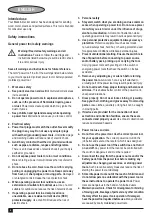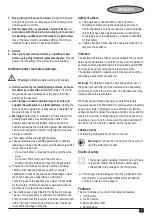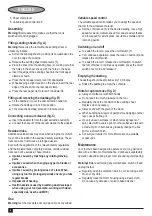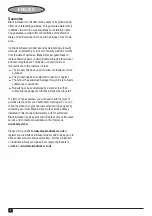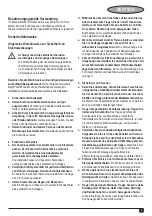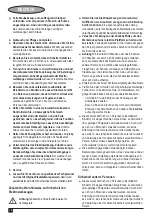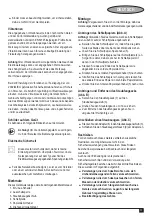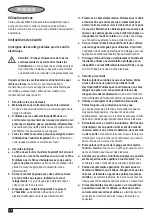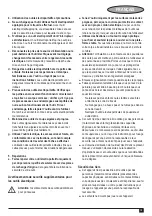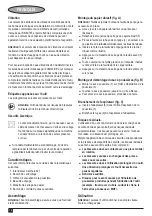
6
ENGLISH
5. Paper clamp lever
6. Variable speed control knob
Assembly
Warning!
Before assembly, make sure that the tool is
switched off and unplugged.
Fitting sanding sheets (fig. A)
Warning!
Never use the tool without a sanding sheet or
accessory in place.
u
Soften the sanding sheet by rubbing its non-abrasive side
over the edge of a worktop.
u
Release the sanding sheet clamp levers (5).
u
Place the sheet onto the sanding base (4), making sure that
the holes in the sheet line up with the holes in the base.
u
Insert the edge of the sanding sheet into the front paper
clamp as shown.
u
Press the front paper clamp lever (5) downwards.
u
While keeping a slight tension on the sheet, insert the rear
edge of the sheet into the rear paper clamp.
u
Press the rear paper clamp lever (5) downwards.
Fitting and removing the dustbag (fig. B)
u
Fit the dustbag (7) over the dust extraction outlet (3).
u
Rotate the dustbag to lock it into position.
u
To remove the dustbag, proceed in reverse order.
Connecting a vacuum cleaner (fig. C)
u
Insert the adaptor (8) into the dust extraction outlet (3).
u
Connect the hose (9) of the vacuum cleaner to the adaptor.
Residual risks.
Additional residual risks may arise when using the tool which
may not be included in the enclosed safety warnings. These
risks can arise from misuse, prolonged use etc.
Even with the application of the relevant safety regulations
and the implementation of safety devices, certain residual
risks can not be avoided. These include:
u
Injuries caused by touching any rotating/moving
parts.
u
Injuries caused when changing any parts, blades or
accessories.
u
Injuries caused by prolonged use of a tool. When
using any tool for prolonged periods ensure you take
regular breaks.
u
Impairment of hearing.
u
Health hazards caused by breathing dust developed
when using your tool (example:- working with wood,
especially oak, beech and MDF.)
Use
Warning!
Let the tool work at its own pace. Do not overload.
Variable speed control
The variable speed control allows you to adapt the speed of
the tool to the workpiece material.
u
Set the control knob (6) to the desired setting. Use a high
speed for wood, medium speed for veneer and synthetics
and low speed for acrylic glass, non-ferrous metals and for
removing paints.
Switching on and off
u
To switch the tool on, press the on/off switch (1).
u
For continuous operation, press the lock-on button (2) and
release the on/off switch.
u
To switch the tool off, release the on/off switch. To switch
the tool off when in continuous operation, press the on/off
switch once more and release it.
Emptying the dustbag
The dustbag should be emptied every 10 minutes.
u
Shake the dustbag to empty the contents.
Hints for optimum use (fig. D)
u
Always hold the tool with both hands.
u
Do not exert too much pressure on the tool.
u
Regularly check the condition of the sanding sheet.
Replace when necessary.
u
Always sand with the grain of the wood.
u
When sanding new layers of paint before applying another
layer, use extra fine grit.
u
On very uneven surfaces, or when removing layers of
paint, start with a coarse grit. On other surfaces, start with
a medium grit. In both cases, gradually change to a fine
grit for a smooth finish.
u
Consult your retailer for more information on available
accessories.
Maintenance
Your tool has been designed to operate over a long period of
time with a minimum of maintenance. Continuous satisfactory
operation depends upon proper tool care and regular cleaning.
Warning!
Before performing any maintenance, switch off and
unplug the tool.
u
Regularly clean the ventilation slots in your tool using a soft
brush or dry cloth.
u
Regularly clean the motor housing using a damp cloth.
Do not use any abrasive or solvent-based cleaner.




